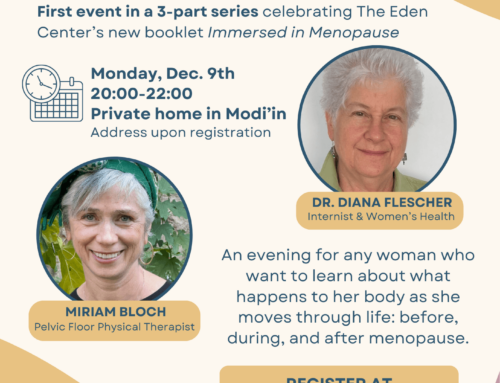 It felt as though I was witnessing a birth. That’s all I could think to say the first time I was present at a conversion. In the years since, having witnessed countless conversions, I have yet to find the words to fully convey the enormity and excitement of the moment. At some point I discovered that I was merely echoing what was expressed in the Talmud over 1500 years ago:
It felt as though I was witnessing a birth. That’s all I could think to say the first time I was present at a conversion. In the years since, having witnessed countless conversions, I have yet to find the words to fully convey the enormity and excitement of the moment. At some point I discovered that I was merely echoing what was expressed in the Talmud over 1500 years ago:
גר שנתגייר כקטן שנולד דמי (יבמות כב ,ע״א)
“A convert who converts is like a newborn child” (Yevamot 22).
In a split-second, someone has shed their old identity and assumed an utterly new one. The gioret (female convert) even acquires a new name, one of her own choosing, further making a distinction, separating her from her previous existence. It’s beyond words.
In Megillat Ruth, Boaz says to Ruth,
.וַתַּעַזְבִי אָבִיךְ וְאִמֵּךְ וְאֶרֶץ מוֹלַדְתֵּךְ וַתֵּלְכִי אֶל עַם אֲשֶׁר לֹא יָדַעַתְּ תְּמוֹל שִׁלְשׁוֹם
“You left your father and mother and the land of your birth and came to a people you had not known before.”
Ruth literally left her parents and her place of birth. For the convert today it need not be so stark, but passing through the mikveh water is the moment when she breaks with the old and explicitly affirms that she is now accepting belief in Hashem and agreeing to adopt new practices. She is looking to the future, as she expresses to Naomi,
וּבַאֲשֶׁ֤ר תָּלִ֙ינִי֙ אָלִ֔ין עַמֵּ֣ךְ עַמִּ֔י וֵאלֹהַ֖יִךְ אֱלֹהָֽי׃ֿ בַּאֲשֶׁ֤ר תָּמ֙וּתִי֙ אָמ֔וּת וְשָׁ֖ם אֶקָּבֵ֑ר
For wherever you go, I will go; wherever you lodge, I will lodge; your people shall be my people, and your God my God. Where you die, I will die, and there I will be buried.
On Shavuot we celebrate the giving of the Torah – it was at Har Sinai that Bnei Yisrael underwent geirut and entered the covenant. The Gemara says that everyone had to go through the process. So it is not surprising that in the days leading up to Shavuot, divrei Torah about geirut (conversion) are everywhere. A search on YUTorah.org for ‘geirut’ yields over 1,500 results and a search for ‘conversion’ another 1,378. The topics (not just on YUTorah but elsewhere as well) are wide-ranging (halakhic, hashkafic, text-based…) but absent seems to be a practical guide to what happens the day of the conversion.
In my many years as a mikveh attendant, I have had the pleasure and the privilege of accompanying many women at the moment of conversion. The gioret has been learning about Shabbat, kashrut, brachot, and more in the run up to the big day when she enters the Jewish people. But does she know what to expect on the day of her geirut? What does the mikveh look like, who will be present at the conversion, what feelings might she experience that day? And how does the balanit (mikveh attendant) fit in?
Whether the balanit is taking a woman observing taharat hamishpacha or a gioret, the preparation at the mikveh is the same, the pool of water is the same, the bracha upon immersion is the same. But differences abound. Conversions are done during the day, not at night. The woman coming at night has been counting her seven clean days; the gioret has been marking the months, perhaps years, that she has been preparing for this moment. The woman immersing at night comes alone and has only the balanit in the room with her (if anyone at all). The gioret, in contrast, often brings the teacher or mentor who has guided her through the conversion process, friends, and on occasion even members of her birth family. For her, the moment of immersion is not a moment of solitude; rather she has a Beit Din of three rabbis in the vicinity, present to affirm her new status and entry into the Jewish people. A young woman coming to use the mikveh as a bride may have taken a tour as part of her high school or seminary education, and those returning for their monthly visits know more or less what to expect. The gioret, on the other hand, probably has no visual context to fall back on and may be apprehensive about what the experience at the mikveh will entail.
In addition to keeping the above in mind, this short list of good practices always helped me as the balanit to make the actual day more pleasant:
- If possible, make a personal connection with the gioret in advance of the day. Have the Beit Din give her your name and contact information and let her know that she can reach out to you with any questions.
- Establish that you are there for her and can act as an intermediary, most particularly if a last-minute question arises that she’s embarrassed to ask the rabbis.
- Arrive early. The gioret often arrives ahead of the scheduled time and it’s nice to be there to greet her.
- Take her on a walk-through. Show her the preparation room and the mikveh pool. Explain where the Rabbanim will be standing. Explain that not only will she be fully covered with a loose robe, but they will only see her from the neck up.
- Find out from her if she has any fears or hesitations. Does she have a fear of water? Does she know how to read Hebrew? Has she learned the bracha she will have to say?
- Reassure her that the bracha is on the wall and it is common, in the intensity of the moment, to stumble over the words.
- Have tissues strategically placed in all the rooms. They will be needed!
Above all, I try to remember that I am participating in creating her first memories post-conversion. As Ruth says to Boaz the first time he speaks to her,
אֶמְצָא־חֵ֨ן בְּעֵינֶ֤יךָ אֲדֹנִי֙ כִּ֣י נִֽחַמְתָּ֔נִי וְכִ֥י דִבַּ֖רְתָּ עַל־לֵ֣ב שִׁפְחָתֶ֑ךָ
“You are most kind, my lord, to comfort me and to speak to your maid servant’s heart.”
So, a conversion takes place during the day and there are men present. Other than that, what makes this immersion stand out from the nighttime immersion? It’s not just the commitment that these women exhibit, but also the courage to embrace something entirely new and different, and to accept – as they affirm moments before they immerse – things they don’t even know about yet.
In the Gemara in Taanit Rabbi Hanina says
הרבה למדתי מרבותי, ומחבירי יותר מרבותי, ומתלמידי יותר מכולן.
“I have learned much from my teachers, and more from any colleagues than from my teachers, but from my students more than all.”
For me, converts are definitely included in the last category! It is inspiring and humbling to experience that moment when the cry of “kosher” is heard; the gioret re-surfaces and a new being enters the world. It is a euphoric moment full of hope and active acceptance.
Ruth, the paradigm of the convert, is known for the chessed she showed. In the very first seconds of her new life, by sharing this moment of great potential and hope for the future, the gioret showers those present with chessed. I hope that at each and every geirut, we the balaniot are able to pay that forward as well.
Rena Karol is a graduate of The Eden Center’s Mikveh Attendant Training Course and has 30 years of experience in all aspects of running a mikveh.








Leave A Comment